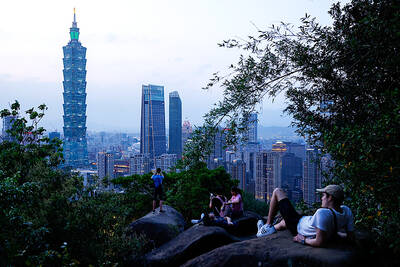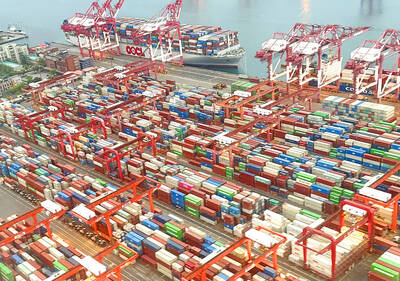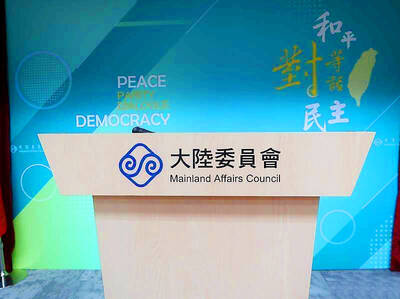Premier Wu Den-yih (吳敦義) responded to legislators’ concerns over nuclear safety yesterday by saying that nuclear power plants in Taiwan were “much safer” than Japan’s Fukushima Dai-ichi because they used “fourth-generation” reactors.
Telling legislators the government would “humbly” review its disaster plans and make any necessary improvements, Wu said he was confident the geological environment in Taiwan and the structure of its nuclear power plants meant that the country was well prepared to withstand any natural catastrophe.
Regarding the safety of the three nuclear power plants in operation — Jinshan Nuclear Power Plant in Shihmen District (石門), New Taipei City (新北市), Guosheng Nuclear Power Plant in Wanli (萬里), New Taipei City and Ma-anshan Nuclear Power Plant in Ma-anshan (馬鞍山), Pingtung County — Wu said all three were “much safer” than Fukushima Dai-ichi, which is the object of international concern following a series of explosions and a possible meltdown.
Asked by Chinese Nationalist Party (KMT) Legislator John Chiang (蔣孝嚴) whether the three nuclear plants were earthquake--resistant, Wu said: “That is difficult to say because even a country like Japan, which is more advanced than us, failed to avert disaster.”
“However, the Fukushima plant was equipped with a third--generation [reactor], while Taiwan’s nuclear power plants operate fourth-generation [sic] ones,” Wu said.
According to related literature, fourth-generation nuclear reactors are still being researched and will not be commercially operational for another two decades or so.
Contacted by the Taipei Times, Chung Ming-lien (鍾明廉), chief of public relations at Taipower Corp, which operates Taiwan’s nuclear plants, said there was no fourth--generation reactor in the country.
The Atomic Energy Council Web site shows the Jinshan power plant uses a BWR-4 (boiling water, second-generation) reactor; the Guosheng plant a BWR-6 (third-generation) reactor; the Ma-anshan plant a PWR (pressurized water, third-generation) reactor; and the No. 4 (Lungmen) will use an ABWR (advanced boiling water, also third-generation) reactor.
Units 2, 3, 4, and 5 at Fukushima Dai-ichi all have BWR-4 reactors similar to that at the Jinshan plant in Taiwan.
Wu also said the containment shells around reactors in Taiwan’s nuclear power plants were thicker than those used in Japan.
In addition, the three operational nuclear power plants in Taiwan were unlikely to be damaged by a tsunami because they were built at elevations of between 12m and 15m, Wu said.
Despite the fact that the No. 4 plant, which is currently under construction, is not located on elevated ground, the likelihood of a tsunami hitting it is also low because “Taiwan has only an outside chance of being hit by tsunamis,” the result of a deep-sea trench off the east coast, Wu said.
“The largest tsunami to ever hit Taiwan was a wave between 4m and 6m recorded in the Keelung area in 1867, while one in the 1900s caused a wave of less than 1m,” he said.
Wu also rallied behind Atomic Energy Council Deputy Minister Huang Tsing-tung (黃慶東), who came under criticism from anti-nuclear activists for drawing an analogy between nuclear power plants established on a consolidated-rock basin and a Buddhist sitting on a lotus platform on Monday to highlight their safety.
“Do you agree with Huang Tsing-tung? Are the nuclear power plants as safe as a Buddhist?” Democratic Progressive Party (DPP) Legislator Kuo Jung-tsung (郭榮宗) asked.
“This was not a groundless analogy,” Wu said.
Wu also said it would be “inappropriate” to fly the national flag at half-mast in sympathy with Japan, as no other country had done so.
“If everyone wears shorts to the swimming pool, but we chose to wear a suit, it would be extremely strange, wouldn’t it,” he said.
Taiwan would observe international protocol, which the Ministry of Foreign Affairs would look into, he said.
DPP Legislator Hsueh Ling (薛凌) said the country flew the national flag at half-mast following the Sept. 11, 2001, attacks in the US.
Meanwhile, DPP lawmakers demanded that Wu order the suspension of construction at the No. 4 plant, a move Wu rejected.
Wu said that the government would make a thorough safety inspection of the plant before it goes into operation, which will now not be the end of this year as planned.
KMT Legislator Lin Yu-fang (林郁方) said halting construction of the plant was “a stupid idea” as it would cost the country large amounts of money for breach of contract.
Rather than halting construction, the government should support and develop systems off the coast to monitor undersea seismic movements to provide warnings of earthquakes and tsunamis, Lin said.
ADDITIONAL REPORTING BY J. MICHAEL COLE AND VINCENT Y. CHAO

MORE VISITORS: The Tourism Administration said that it is seeing positive prospects in its efforts to expand the tourism market in North America and Europe Taiwan has been ranked as the cheapest place in the world to travel to this year, based on a list recommended by NerdWallet. The San Francisco-based personal finance company said that Taiwan topped the list of 16 nations it chose for budget travelers because US tourists do not need visas and travelers can easily have a good meal for less than US$10. A bus ride in Taipei costs just under US$0.50, while subway rides start at US$0.60, the firm said, adding that public transportation in Taiwan is easy to navigate. The firm also called Taiwan a “food lover’s paradise,” citing inexpensive breakfast stalls

TRADE: A mandatory declaration of origin for manufactured goods bound for the US is to take effect on May 7 to block China from exploiting Taiwan’s trade channels All products manufactured in Taiwan and exported to the US must include a signed declaration of origin starting on May 7, the Bureau of Foreign Trade announced yesterday. US President Donald Trump on April 2 imposed a 32 percent tariff on imports from Taiwan, but one week later announced a 90-day pause on its implementation. However, a universal 10 percent tariff was immediately applied to most imports from around the world. On April 12, the Trump administration further exempted computers, smartphones and semiconductors from the new tariffs. In response, President William Lai’s (賴清德) administration has introduced a series of countermeasures to support affected

CROSS-STRAIT: The vast majority of Taiwanese support maintaining the ‘status quo,’ while concern is rising about Beijing’s influence operations More than eight out of 10 Taiwanese reject Beijing’s “one country, two systems” framework for cross-strait relations, according to a survey released by the Mainland Affairs Council (MAC) on Thursday. The MAC’s latest quarterly survey found that 84.4 percent of respondents opposed Beijing’s “one country, two systems” formula for handling cross-strait relations — a figure consistent with past polling. Over the past three years, opposition to the framework has remained high, ranging from a low of 83.6 percent in April 2023 to a peak of 89.6 percent in April last year. In the most recent poll, 82.5 percent also rejected China’s

PLUGGING HOLES: The amendments would bring the legislation in line with systems found in other countries such as Japan and the US, Legislator Chen Kuan-ting said Democratic Progressive Party (DPP) Legislator Chen Kuan-ting (陳冠廷) has proposed amending national security legislation amid a spate of espionage cases. Potential gaps in security vetting procedures for personnel with access to sensitive information prompted him to propose the amendments, which would introduce changes to Article 14 of the Classified National Security Information Protection Act (國家機密保護法), Chen said yesterday. The proposal, which aims to enhance interagency vetting procedures and reduce the risk of classified information leaks, would establish a comprehensive security clearance system in Taiwan, he said. The amendment would require character and loyalty checks for civil servants and intelligence personnel prior to